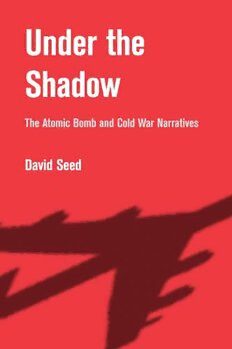
Under The Shadow: The Atomic Bomb and Cold War Narratives PDF
Preview Under The Shadow: The Atomic Bomb and Cold War Narratives
Under the Shadow The Atomic Bomb and Cold War Narratives David Seed UNDER THE SHADOW Under the Shadow The Atomic Bomb and Cold War Narratives David Seed THE KENT STATE UNIVERSITY PRESS KENT, OHIO © 2013 by The Kent State University Press, Kent, Ohio 44242 All rights reserved Library of Congress Catalog Card Number 2012039121 isbn 978-1-60635-146-8 Manufactured in the United States of America Library of Congress Cataloging-in-Publication Data Seed, David. Under the shadow : the atomic bomb and Cold War narratives / David Seed. p. cm. Includes bibliographical references and index. isbn 978-1-60635-146-8 (hardcover) ∞ 1. American fiction—20th century—History and criticism. 2. Cold War in literature. 3. Atomic bomb in literature. 4. Cold War in motion pictures. I. Title. ps374.c57s44 2012 813'.54093581—dc23 2012039121 17 16 15 14 13 5 4 3 2 1 For Joanna Contents Introduction 1 1 The Atom—From H. G. Wells to Leo Szilard 9 2 The Dawn of the Atomic Age—The Bomb and Hiroshima 24 3 The Debate over Nuclear Refuge 42 4 Do-It-Yourself Survival 62 5 Philip Wylie on the State of the Nation 75 6 Cultural Cycles in Walter M. Miller’s A Canticle for Leibowitz 95 7 The Pathology of Warfare in Bernard Wolfe’s Limbo 112 8 Push-Button Holocaust in Mordecai Roshwald’s Level 7 130 9 Whales, Submarines, and The Bedford Incident 147 10 Nuclear Safety Procedures in Fail-Safe 163 11 Uncovering the Death Wish in Dr. Strangelove 181 12 Mapping the Postnuclear Landscape 199 13 Future Reportage on World War III 215 14 Beyond the Cold War 231 Notes 243 Bibliography 272 Index 287 Introduction The time is one year in the near future. An American professor of physics returns to his hometown after a nuclear war to find it completely flattened. The aggressors are unknown; they are simply the “people with bombs and planes.”1 It seems as if civilization itself has been destroyed—that is, until a piece of uranium isotope is discovered that releases powerful energy from the thought waves of the individual holding it. At this point the novel, Murray Leinster’s Fight for Life, slides from a disaster narrative into a compensatory fantasy. The protagonist summarizes the nuclear subject as marking the demise of war as we know it. “There can’t be an atomic battle,” he declares. “There can only be atomic massacre. There can’t re- ally be an atomic war. There can only be a contest in destruction.”2 The attack on America is depoliticized into an act of blind force. The novel was published in 1947, before the Soviet Union developed a nuclear capability, which legitimized its new status as the national enemy. In short, nuclear war is presented as the ultimate act that denies the citizen any option but the sheer need to survive, and this is where Leinster’s quasi-magical isotope comes in. Extrapolated partly on an analogy with J. B. Rhine’s experiments at Duke Uni- versity into parapsychology, it restores power to the individual and rescues him from being a plaything of blind chance. What is striking about Leinster’s novel is its generic indeterminacy. It was marketed simply as a “novel of the atomic age,” but the nuclear subject contorts its narrative, which veers from an unpalatable evocation of ultimate endings into a series of fanciful speculations about the power of the mind to alter the present and maybe also the future. Leinster’s novel represents an early demonstration of one of the main themes in this volume, namely the challenges to expression posed by the nuclear subject and the narrative contortions that resulted. INTRODUCTION 1
